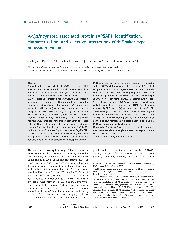摘要
The vertebrate post-synaptic density (PSD) is a region of high molecular complexity in which dynamic protein interactions modulate receptor localization and synaptic function. Members of the membrane-associated guanylate kinase (MAGUK) family of proteins represent a major structural and functional component of the vertebrate PSD. In order to investigate the expression and significance of orthologous PSD components associated with the Aplysia sensory neuron-motor neuron synapse, we have cloned an Aplysia Dlg-MAGUK protein, which we identify as Aplysia synapse associated protein (ApSAP). As revealed by western blot, RT-PCR, and immunocytochemical analyses, ApSAP is predominantly expressed in the CNS and is located in both sensory neuron and motor neurons. The overall amino acid sequence of ApSAP is 55-61% identical to Drosophila Dlg and mammalian Dlg-MAGUK proteins, but is more highly conserved within L27, PDZ, SH3, and guanylate kinase domains. Because these conserved domains mediate salient interactions with receptors and other PSD components of the vertebrate synapse, we performed a series of GST pull-down assays using recombinant C-terminal tail proteins from various Aplysia receptors and channels containing C-terminal PDZ binding sequences. We have found that ApSAP selectively binds to an Aplysia Shaker-type channel AKv1.1, but not to (i) NMDA receptor subunit AcNR1-1, (ii) potassium channel AKv5.1, (iii) receptor tyrosine kinase ApTrkl, (iv) glutamate receptor ApGluR1/4, (v) glutamate receptor ApGluR2/3, or (vi) glutamate receptor ApGluR7. These findings provide preliminary information regarding the expression and interactions of Dlg-MAGUK proteins of the Aplysia CNS, and will inform questions aimed at a functional analysis of how interactions in a protein network such as the PSD may regulate synaptic strength.
- 出版日期2008-5
